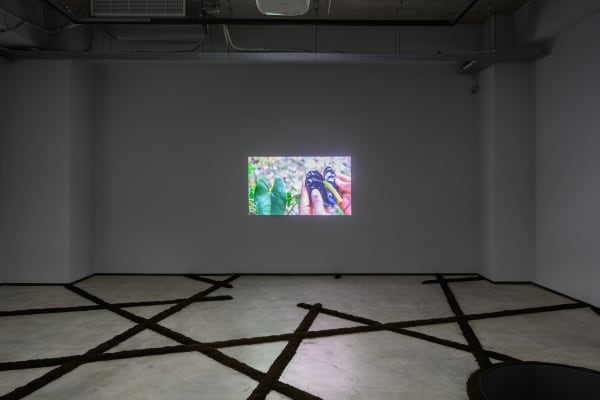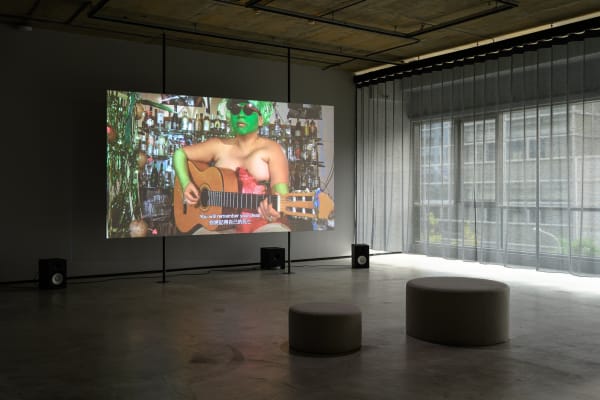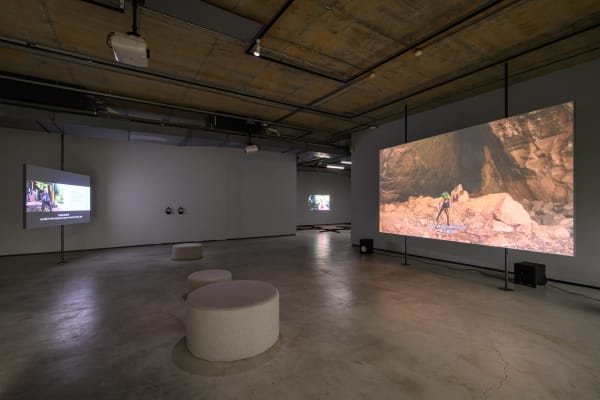How to Sing Our Songs on Their Land: Tsou Ting
Dates
5 NOVEMBER 2022 - 7 JANUARY 2023
Reception
5 NOVEMBER (SAT.) 4:30 p.m.
TKG+ Projects 2F, No. 15, Ln. 548, Ruiguang Rd., Neihu Dist., Taipei 11492, Taiwan
Curator
Tsou Ting
Participating Artists
Minia Biabiany, En-Man Chang, Naomi Rincón Gallardo
How do people without a land earn the right to use it? If the land could be distributed and privatized, who has the say in the ownership of the land? When does this ownership start or end? And is humanity the only one entitled to the land? Curator Ting Tsou and artists Minia Biabiany, En-Man Chang, and Naomi Rincón Gallardo together interrogate land ownership and rights in the exhibition How to Sing Our Songs on Their Land. In a closely woven narrative and artistic practices that resonate with each other, they examine through animal fables and songs, the improper allocation of contemporary social resources, as well as the historical silencing, plundering, and marginalization of indigenous peoples during the colonial period that has largely gone unseen.
Moving with imagery, narrated in song, this exhibition accentuates the interrelationship among different cultures, histories, stories, humans, and nonhumans, juxtaposed against a backdrop crafted from sound and scene that aims to captivate the viewer. Inspired by concepts of how-to, other and self, land and song, the exhibition embodies both an attempt to delineate the land through imagery, and a curatorial experiment with song as a narrative device.
To initiate a context with how-to is to introduce practical methods or instructions, with which to facilitate the understanding of something new or the entering of a new situation. The idea of other and self identifies a relationship of duality that begins with the individual, and remains in a constant state of flux according to the environment: when the boundary between self and other is distinguished, different gestures of people arise. These countless collectives born out of shifting positions are a temporary assemblage of differences, anchoring what defines them and me.
On the land of others, how does one sing, about whose land, and with whose song? Land and song morph into a mise-en-scène and common lands in this exhibition — a temporary amalgamation of time and space. Land specifies human geography, while singing becomes an approach to lure the viewer into staying. Whenever the melody starts playing, it seems like we can’t help but stop and listen to the strange yet familiar music, no matter where we are. Could the moment when the visual narrative unfolds before our eyes and resonates in our ears, manifest itself in song and lead to new/unknown knowledge?
Hailing respectively from the Oaxaca Valley, Mexico; the mountains and islands of Guadeloupe, France; and the indigenous houses in Taitung, Taiwan, together Naomi Rincón Gallardo, Minia Biabiany, and En-Man Chang narrate in singsong a hybrid fable about contemporary humanity with animals as protagonists, mapping dreams of motherland and land struggles in real life. The immortal opossum, which stole fire and gave it to humans in Native American folklore, encounters a mining tycoon illegally forcing the indigenous people off their land. Gently holding a chrysalis that guides them home, a child from the French-colonized Guadeloupe sings a Creole nursery rhyme, and waits for the road home to unfold. As imperialism invades Taiwan, the tapestry of an imagined motherland is slowly woven from Austronesian peoples, the paper mulberry, and the Giant African Snail — both an agricultural pest and a delicacy. Cast in new light, these animal-centered tales escape from an anthropocentric perspective, and sing of a homeland in reality limned through oral history, social issues, and survival dilemmas. These very tales further transcend knowledge backgrounds, and appeal directly to the senses by conjuring an experience that probes a complex palimpsest of colonial history, land conflict, and ethnic politics.
When the music stops and the screen dims, we are transported from a fictional song to the real life. Beyond the boundary of art, amid justice unsought and voices stifled in the strata of colonial history and depths of the contact zone, how does the silenced sing a song of their own on the land of others?
Participating Artists
Minia Biabiany
Born in 1988 in Guadeloupe, Minia Biabiany works and lives in Guadeloupe. In her practice she observes how the perception of the body is entangled with the perception of space, land and history. Mainly in installations and videos, she examines the paradigm and the gestures of weaving by creating poetic and political narratives linked with self-understanding and healing. She explores the possibility of an enunciation out of the dominant colonial storytelling particularly in the context of Guadeloupe, and of the taboo of the consequences of the French assimilation in the relationship between the population, the land, and plants.
Biabiany initiated the artistic and pedagogical collective project Semillero Caribe in 2016 in Mexico City, and continues to explore the deconstruction of narratives with the sensations of the body and concepts from Caribbean authors with the experimental platform Doukou.
She studied in the fine art school ENSBA Lyon in France. Her work has been shown in the 10th Biennale de Berlin, TEOR/éTica in Costa Rica, Witte de Wite in Rotterdam, Cràter Invertido in Mexico, Prix Sciences Po pour l'art contemporain 2019 in Paris, SIGNAL in Malmö, and will soon exhibited in the Palais de Tokyo in fall 2022. Her first multilingual monograph Ritmo Volcan just came out at the publishing house Temblores.
En-Man Chang
Born in Taitung, Taiwanese artist En-Man Chang currently works and lives in Taipei. Utilizing the forms of the moving image, photography, installation, and creative forms of self-organizing and collective projects, Chang’s practice explores how the indigenous people of Taiwan negotiates the ever-shifting socio-cultural terrains and conditions for survival in contemporary Taiwan against the backdrop of modernization and urbanization, rooted in her own experiences and heritage as a half-indigenous person. With this as a point of departure, Chang excavates lost histories and narratives to explore the world at large, aiming to embody the transformative potential that art holds.
Chang has had solo exhibitions in Taipei (2012), Vancouver (2016), Los Angeles (2017); participated in group shows in Thailand (2014), Milan (2015), Auckland (2016), Poland (2017), Hong Kong (2020); and exhibited in major projects such as the Taipei Biennial (2014), Taiwan Biennial (2018), Istanbul Biennial (2019), Cosmopolis #2 - Centre Pompidou (2019), Singapore Biennale (2019), Kathmandu Triennale (2022), and Documenta Fifteen (2022).
Naomi Rincón Gallardo
Born in 1979, Naomi Rincón Gallardo is a visual artist and researcher currently living and working between Mexico City and Oaxaca. From a decolonial-cuir perspective, her research-driven critical-mythical dreamlike worldmakings address the creation of counterworlds in neo-colonial settings. In her work she integrates her interests in theater games, popular music, Mesoamerican cosmologies, speculative fiction, vernacular festivities and crafts, decolonial feminisms and queer of color critique. She completed the PhD in Practice Program at the Academy of Fine Arts Vienna. She is currently a beneficiary of the Sistema Nacional de Creadores de Arte, FONCA (2019–2022), Mexico.
Solo exhibitions include: Una trilogía de cuevas (A Trilogy of Caves), Museo de Arte Contemporáneo de Oaxaca, Oaxaca, Mexico (2020); May your thunder break the sky, Kunstraum Innsbruck, Innsbruck, Austria (2020); Heavy Blood, Museo Experimental El Eco, Mexico City, Mexico (2019); Opossum Resilience, Parallel Oaxaca, Oaxaca, Mexico (2019).
Group exhibitions include: Venice Biennale (2022); São Paulo Biennial (2021); Berlin Biennale (2020); Stone Telling, Kunstraum Niederösterreich, Vienna, Austria (2019); FEMSA Biennial: WeHave Never Been Contemporary, Zacatecas, Mexico (2018); Prometheus: Four Artists From Mexico Revisit Orozco, Benton Museum of Art at Pomona College, Claremont, U.S. (2017); Odarodle: An imaginary their_story of naturepeoples, 1535–2017, Schwules Museum, Berlin, Germany (2017); Nicaragua Biennial, Managua, Nicaragua (2016). Performative screenings include: En Cuatro Patas, Pacific Standard Time Festival: LA/LA, The Broad, L.A., U.S. (2018); The Formaldehyde Trip, Performance in Progress, SFMOMA, San Francisco, U.S. (2016).
Curator
Ting Tsou
Ting Tsou is a curator, researcher and writer who lives and works in Berlin and Taipei. She is currently a doctoral candidate at the Academy of Fine Arts in Leipzig, Germany. In recent years, her texts have appeared in such periodicals as ARTouch, Artist Magazine, Artforum, CLABO, No Man’s Land and other media. Her research interests lie in the cultures of the curatorial and exhibition history, with a focus on transdisciplinarity, contemporaneity and archive studies.
Her recent curatorial and research projects include Housing Things (Yo-Chang Art Museum, New Taipei City, Taiwan, 2021), Jinshan No. 14 (Chiayi Art Museum, Chiayi City, Taiwan, 2022), “The Whole Life: An Archive Project” (Haus der Kulturen der Welt, Berlin, Germany, 2019-2022), and the “Floating System for Snails: Project Invasion” in Documenta Fifteen (in collaboration with En-Man Chang and Han-Fang Wang, Kassel, Germany, 2022).
























